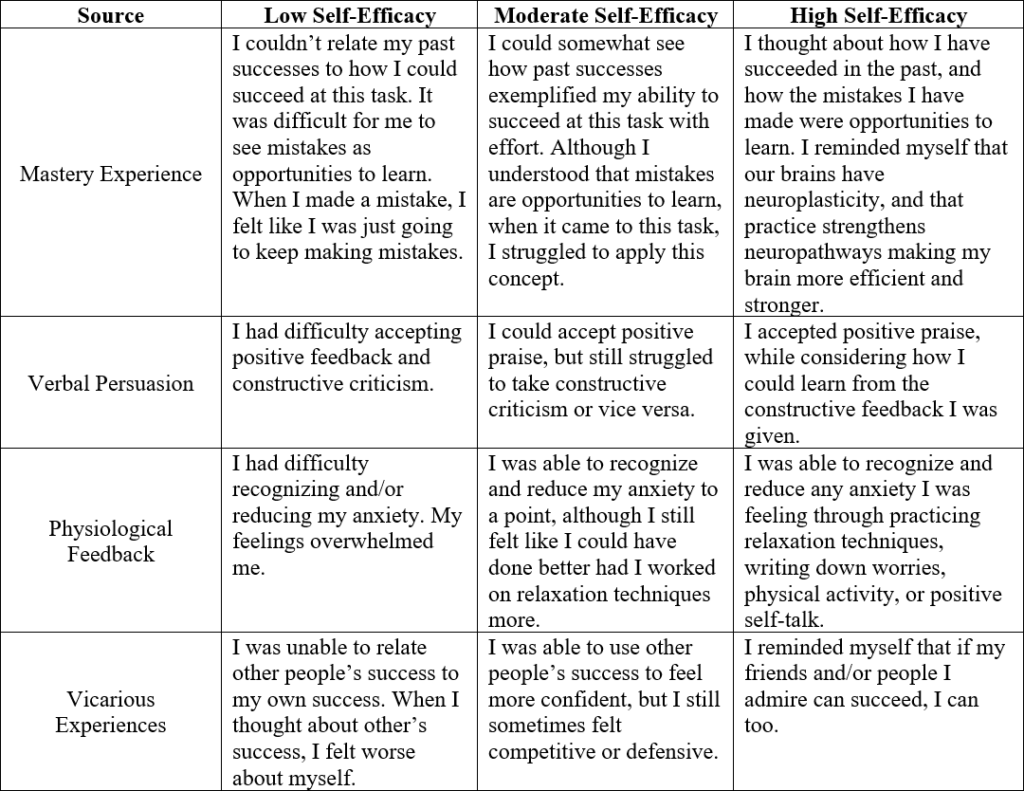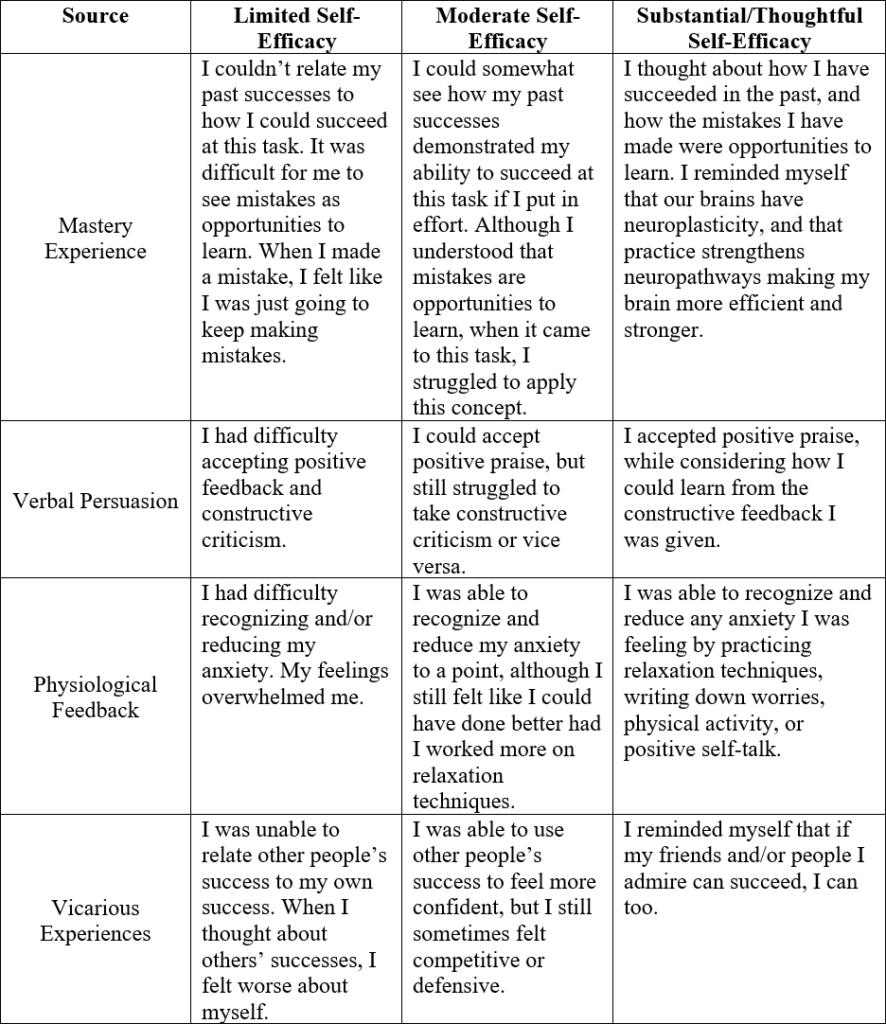Part 1: Teaching Students What Self-Efficacy Is and Why It Is Important
Part 2: Helping Students Understand Their Strengths and Challenges in Self-Efficacy
- Teach Students: 2a. Self-Efficacy Statements
- The Self-Efficacy Knowledge Test
- Creating an Account to Administer the Self-Efficacy Knowledge Test
- Teach Students: 2b. Identify Self-Efficacy Strengths
- Teach Students: 2c. Brainstorming Ways to Improve
Part 3: Approaching Challenges With a Growth Mindset
Part 4: Embedding Opportunities for Students to Practice Self-Efficacy
Part 5: The College and Career Competency Framework
Part 2: Helping Students Understand Their Strengths and Challenges in Self-Efficacy
Learning Target: Students can identify their strengths and challenges related to self-efficacy.
In this part, we will explore activities that help students better understand self-efficacy concepts and determine areas for personal growth. Students will be asked to reflect on their current behaviors and attitudes related to self-efficacy in order to identify which component is a challenge for them. Everyone has varying levels of self-efficacy which are specific to certain tasks. While it is important in life to play to our strengths, we also need to know that we can learn and improve in any skill if we put in the effort and take steps to build our confidence in our abilities.
“Teach Students: Self-Efficacy Statements” will reinforce some of the key concepts your students have learned about self-efficacy, including that it is not related to how smart you are and that confidence in one area doesn’t equal self-efficacy in other areas.
Teach Students: 2a. Self-Efficacy Statements
Provide students with a brief review of both self-efficacy components. Then, divide the class into four groups and have each group discuss one of the below statements.
Each group should read their assigned statement, discuss, and summarize their thoughts about its meaning to share with the class. Students should record their responses on the “Teach Students: 2a. Self-Efficacy Statements” handout (Handout 2a. linked to on page 11 of your Educator Workbook). To generate discussion among the students, you may need to provide some guiding questions (e.g., How does this statement reinforce what you have learned about self-efficacy? How does this statement relate to identifying areas of strength and challenge related to self-efficacy?). Then, encourage each group to share their summarized thoughts with the class.
- As individuals, we have varying levels of self-efficacy, depending on the area. For example, in some goals or challenging tasks, we feel confident and know how to succeed. But in others, we have lower confidence in our abilities, and this can cause issues.
- Our level of self-efficacy often changes over time based on our experiences. In other words, when we are able to complete challenging tasks, our self-efficacy increases. The opposite is also true: failures can lead to lower confidence, especially when we give up.
- Self-efficacy has NOTHING to do with how smart we are. You can be very smart and still have low confidence in some areas.
- Just because we have confidence that our skills can increase in some areas, such as basketball or singing, it doesn’t mean we are automatically confident in everything. We can all become more self-efficacious in various areas.
2a. Reflect and Apply: Take a few minutes and review the Self-Efficacy Performance-Based Reflection tool (located on page 15 of the Technical Guide). This tool asks students to reflect on their application of each self-efficacy source related to a specific assignment, task, or goal.

Considering your classroom activities, when could you ask students to use the reflection tool to improve their practice of self-efficacy? Jot down your thoughts on page 6 of the Educator Workbook.
The Self-Efficacy Knowledge Test
One way to help students determine their areas of strength and the challenges they face related to self-efficacy is to administer the Self-Efficacy Knowledge Test (Gaumer Erickson et al., 2022). The assessment is written at a fifth-grade reading level, and accommodations can include reading the items aloud or explaining the items. It is divided into three sections. The Questionnaire section (Items 1–24) has students rate themselves on a scale from not like me to very like me for each self-efficacy behavior/attitude described; there are no right or wrong answers in this section. Each item fits within one of the components. Students’ responses in this section are automatically compiled to show which component is their area of strength and which component is more challenging for them. The Knowledge Test section (Items 25–44) assesses students’ knowledge of self-efficacy concepts with true/false and multiple-choice items. There are correct answers for each of these items, and they are automatically scored when the assessment is submitted. Finally, the Essay (short answer) section (Item 45) asks students to respond to a scenario and will need to be scored by a teacher.
The questionnaire helps students recognize which self-efficacy components are areas of strength and which components are more of a challenge. In addition, the knowledge assessment can determine their knowledge of self-efficacy concepts, which is often more limited than students anticipate. This awareness can help with gaining student buy-in for learning. For more information on utilizing the Self-Efficacy Knowledge Test to measure students’ growth in self-efficacy, see the Self-Efficacy Assessment Suite: Technical Report (Gaumer Erickson & Noonan, 2022).
Creating an Account to Administer the Self-Efficacy Knowledge Test
To administer the Self-Efficacy Knowledge Test to students, educators create an account on https://www.cccstudent.org/, a free assessment site (students do not need accounts). Once you have given the Self-Efficacy Knowledge Test, you can view and analyze classroom and individual student results on this site. The assessment results can be used to help refine instruction, and students and educators can use the results to show growth in knowledge of self-efficacy. Additional details for launching an assessment and reviewing the results are provided on the website.
As students are learning about self-efficacy, it is important that they reflect on how well they are addressing each component as they work to complete challenging tasks. In “Teach Students: 2b. Identify Self-Efficacy Strengths,” students rate their current level of effort (Component 1) as well as identify the steps they are taking or could take to increase their confidence (Component 2). This activity will help students to be more aware of when they are applying effort and what strategies they are using to continue putting forth effort.
Teach Students: 2b. Identify Self-Efficacy Strengths
Remind students that we all have strengths and areas to improve when it comes to self-efficacy.
Help students determine a key learning objective for a particular class or assignment. Next, ask students to rate how well they are addressing each component on the “Teach Students: 2b. Identify Self-Efficacy Strengths” handout (Handout 2b. linked to on page 11 of your Educator Workbook). Support students in writing specific things they are doing or could do to address each component, and have students give themselves an overall rating on the task they identified in the first column. This activity can be used throughout instruction to help students practice reflecting on their level of effort and progress and identifying how they can increase their confidence when they begin challenging tasks in class.

2b. Reflect and Apply: Think about a task or goal you are currently working towards, personal or professional. Describe how well you are addressing each component, writing specific things you are doing or could do to address each component; give yourself an overall rating on the task you identified. Use page 6 of the Educator Workbook to record your answers.
In the next activity, students identify specific actions they will take over the next week to improve their self-efficacy and reflect on their efforts to determine how well their efforts are working. Examples might include identifying challenges they anticipate in the upcoming week and brainstorming strategies they are going to use to increase their confidence when they face challenges.
Teach Students: 2c. Brainstorming Ways to Improve
Remind students that to increase our self-efficacy, we have to focus on our effort, progress, and learning, as well as use strategies to increase our confidence when we have a challenging task we want to complete. Review the four sources that build self-efficacy, and provide students with an example strategy from each source that could be used to increase their confidence (e.g., Verbal Persuasion—using positive self-talk and accepting feedback from others, Physiological Feedback—taking deep breaths to calm physiological reactions, Mastery Experiences—remembering your past successes to build your self-efficacy on the current task, Vicarious Experiences—seeing others who are similar to me succeed and using that observation to build my own self-efficacy).
Tell your students that over the next week, they are going to practice focusing on their effort and using strategies to increase their confidence by completing a week-long journaling activity. First, ask students to identify a challenge they are likely to face in the upcoming week. Then, divide students into small groups and have them brainstorm strategies each group member could use to increase their confidence in overcoming the challenge.
Ask students to write their anticipated challenge and the strategies they will use the “Teach Students: 2c. Brainstorming Ways to Improve” handout (Handout 2c. linked to on page 11 of your Educator Workbook). Then, using the guiding questions below, students should reflect daily to determine if they are putting forth effort and making progress. They should also reflect on how the self-efficacy strategies they are using are impacting their ability to complete a challenging task.
- Am I putting forth effort to complete the task? How do I know I am putting forth effort?
- Am I making progress? How do I know I am making progress?
- How are the self-efficacy strategies I said I would use increasing my confidence that I can complete the task?
- What other self-efficacy strategies could I try this week to increase my confidence in completing the challenging task?
2c. Reflect and Apply: You have learned about the self-efficacy components and how practicing both components over time will increase your self-efficacy, as well as about the four sources that build self-efficacy. Now it’s your turn to anticipate a challenge you might have in providing self-efficacy instruction to your students.
Identify likely challenges in providing self-efficacy instruction and how you will focus on your effort, progress, and learning as well as the strategies you will use to increase your confidence as you provide self-efficacy instruction. Then, jot your answers down on page 7 of the Educator Workbook. Consider extending this activity into a week-long journaling activity by taking time each day to focus on your effort and progress in providing self-efficacy instruction and which strategies you are finding to be the most helpful in increasing your confidence.
